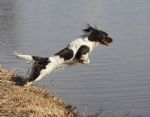History
According to the English Springer Spaniel Club (The Parent Club of Great Britain), the term "Spaniel" comes from either the Roman name for Spain - "Hispania" - or the French term for Spaniels - "Chiens du Espagnol" - or dogs from Spain. Although we cannot know for certain the origins of a breed with more than 2000 years of history, there is general agreement that the Spaniel was a native of Spain and was spread through Europe by the Romans.
In 1387 Gaston de Foix, a rich and powerful lord of Southern France who was famous for his hunting feats, described hunting dogs in their work as quartering in front of the master, flushing game and retrieving from land and water - characteristics of the field-bred English Springer Spaniel that we know and love today.
Prints and paintings from the 16th and 17th centuries depict dogs of a similar Spaniel type, some with docked tails. The dog was used to "spring" or "flush" game, both feather and fur, for hawks, coursing hounds and nets. The invention of the wheel lock firearm in the 17th century revolutionised hunting and the Spaniel was highly successful at flushing game for this purpose.
By the 19th century, Spaniels had begun to be divided into two groups: dogs weighing up to approximately 12kg were used for hunting woodcock and were thus called "Cocking" or "Cocker" Spaniels whilst the larger dogs in the litter were called "Field" or "English" Spaniels. By 1812 a pure strain of English Springer Spaniels was started. "Mop 1", bred by the Boughey family of Aqualate in Shropshire, although more like a Clumber in build with a slightly curly coat, was the first true Springer type.
Sources:
English Springer Spaniel Club (UK)
English Springer Spaniel Field Trial Association (AKC)
© Thornfield English Springer Spaniels 2024
